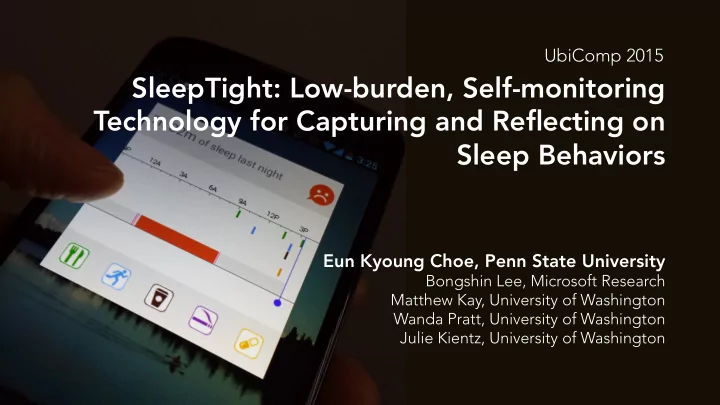

UbiComp 2015 SleepTight: Low-burden, Self-monitoring Technology for Capturing and Reflecting on Sleep Behaviors Eun Kyoung Choe, Penn State University Bongshin Lee, Microsoft Research Matthew Kay, University of Washington Wanda Pratt, University of Washington Julie Kientz, University of Washington UbiComp 2015 1
Self-monitoring An activity of recording one’s own behaviors, thoughts, or feelings [ Kopp, J. (1988) Self-monitoring: A literature review of research and practice] UbiComp 2015 2
Self-monitoring is important Therapeutic Purpose Being aware of how you are doing can result in reactivity * and enable you to change behavior or maintain appropriate behavior * Reactivity : The change in the frequency of a target behavior Nelson & Hayes. (1981) UbiComp 2015 3
Data Capture Mechanisms Manual Automated Capture Capture UbiComp 2015 4
Manual Capture Increased self-awareness Engagement with data Flexibility of choosing target behaviors Some data can only be tracked manually High capture burden Forgetting -> compromised data accuracy UbiComp 2015 5
Automated Capture Reduced mental load Better accuracy (depending on the data) Cumbersome to wear (wearable sensing) Reduce engagement with data UbiComp 2015 6
Data Capture Mechanisms Manual Automated Capture Capture Lullaby (Kay et al., 2012) Sleepful app Toss ‘N’ Turn SWP Somnometer (Lawson et al., 2013) (Chen et al., 2013) (Min et al., 2014) (Shirazi et al., 2013) UbiComp 2015 7
Sleep Tracking http://www.swedish.org Sleep Center Patient Resource. UbiComp 2015 8
Goal To support easy & flexible manual capture of multiple behavior factors UbiComp 2015 9
SleepTight Design Goals 1. Capture both target behaviors and contributing factors A E B Sleep D C F Target behaviors Contributing factors UbiComp 2015 10
SleepTight Design Goals 1. Capture both target behaviors and contributing factors 2. Reduce the capture burden UbiComp 2015 11
SleepTight Design Goals 1. Capture both target behaviors and contributing factors 2. Reduce the capture burden 3. Provide feedback to promote self-reflection UbiComp 2015 12
SleepTight Design Capturing Multiple Behaviors Leveraging App Widget Feedback UbiComp 2015 13
Capturing Multiple Behaviors Target behaviors: Sleep Contributing factors Custom Behaviors UbiComp 2015 14
Capturing Multiple Behaviors Target behaviors: Sleep Contributing factors UbiComp 2015 15
Leveraging App Widget UbiComp 2015 16
Leveraging App Widget # of unlocking event / day 4.8-105.3 times Truong et al., (2014) Lock screen Home screen UbiComp 2015 17
Leveraging App Widget Lower Capture Burden Lower Access Burden UbiComp 2015 18
Feedback for Self-reflection Daily View 4-week View Comparison View UbiComp 2015 19
Study Design Regular app App-only System Condition UbiComp 2015 20
Study Design Regular app Lock screen widget Home screen widget Full System Condition UbiComp 2015 21
Study Design A three-phased study • Interview • 4-week deployment • Debriefing interview • Questionnaire • Weekly survey • Questionnaire • Instruction 22 participants (9 Males, 13 Females) Average age—29.7 years old (range: 20-49) Random assignment UbiComp 2015 22
Findings Data Capture Behaviors Information Access Self-reflection UbiComp 2015 23
Data Capture Behavior [Diary adherence] 92% > 73% 88% of the sleep diaries were captured (M = 25.89, (M = 20.42, p = .03 from the widgets SD = 2.71) SD = 7.18) UbiComp 2015 24
Data Capture Behavior [# of total contributing factors] 9% of the contributing Full system: 151.11 (SD = 68.82) factors were captured from the widgets App-only system: 141.5 (SD = 78), p = N/S UbiComp 2015 25
Time Difference b/w Event Time and Logging Time < Full System: 7.1 hours App-only System: 11.7 hours (SD = 3.33) (SD = 5.00) p = .02 UbiComp 2015 26
Self-reflection Self-reflection during opportune moments: What did you learn? Finding-Sleep pattern “…my time to go to bed is a little inconsistent” (neutral statement) Finding-Other activity “…I don’t drink as much alcohol as I thought I did” (disproof) Hypothesis- “…drinking alcohol seems to lead to poor sleep.” Relationship between sleep and other factors UbiComp 2015 27
Designing Successful Manual Tracking Tools UbiComp 2015 28
Lower the User Burden Lower the Capture Burden Lower the Access Burden Leverage Visual Reminders UbiComp 2015 29
Leverage Manual Tracking in Self-reflection Reflection Reflection when during data receiving capture feedback Configuration Data capture Feedback UbiComp 2015 30
Thank you! Funding: Intel ISTC Pervasive Computing NSF Awards 1344613 Google Eun Kyoung Choe echoe@ist.psu.edu faculty.ist.psu.edu/choe UbiComp 2015 31
Recommend
More recommend